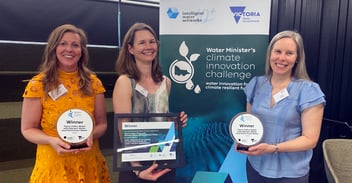Circular economy improves business outcomes
Embedding sustainability and regenerative principles — regardless of the name they go by — into business strategies is increasingly becoming the norm. No longer are environmental considerations merely an afterthought, tacked on to meet compliance requirements. Instead, this approach is presenting new opportunities for water utilities businesses to explore and adopt — and a circular economy lens is a key framework that can progress this aim.
Having just embarked on its new, long-term 2030 Strategy, Yarra Valley Water is thinking about how it can operate differently from the outset.
“The 2030 Strategy was really founded on a regenerative mindset; meeting compliance is just not enough to prevent environmental degradation,” said Dr Lisa Ehrenfried, Manager, Resilience and Liveability, at Yarra Valley Water.
“We want to look more holistically at our impacts, the opportunities, thereby fulfilling our purpose of supporting the health and wellbeing of our customers and creating a brighter future for communities and the natural environment.”
A shift in mindset
It’s a holistic approach that looks to the environment itself.
“There is no waste in nature, and we are a part of nature, so how can we be more like nature in how we operate?” explained Ehrenfried.
With that regenerative mindset, Yarra Valley Water identified three elements to frame its change: going beyond zero carbon, healthy ecosystems and circular economy, with the latter being the key process to realising the changes desired.
“The idea of those three elements is that environmental outcomes are really integral to everything we do. It’s not just an add-on to be done in one particular area but it’s really done across the entire business operations, design, and delivery. A key goal of our 2030 Strategy is to embed these three elements, and to become a regenerative business.”
And the circular baseline framework analysis helps to identify opportunities and establish priorities.
“You’re not just jumping at the first thing that looks like it’s the best, but you really understand where the biggest and best opportunities are and then can focus the effort on that. The analysis has really helped us pinpoint the focus.”
Confirmation and expansion
Assessing the business using circular economy principles has also had the practical benefit of not only confirming some well-informed speculations, but also revealing other advantages that otherwise may not have been realised.
Ehrenfried cites using recycled material such as crushed glass in lieu of sand and aggregate as one such example. Already well regarded on the basis that it minimises waste to landfill, the framework made its use even more compelling, she said, as it “really highlighted that using recycled aggregate is a massive opportunity to be pursued”.
“What’s become really obvious is that a key driver is carbon because you save so much CO2 equivalent by using the recycled materials in the embedment,” she said.
The framework is significant too for what it reveals about carbon, one of the most recognised and important measures of a business’ environmental credentials. The analysis helped identify the most energy-efficient — and therefore, carbon-efficient — method of establishing infrastructure.
Yarra Valley Water compared two key methods of pipe installation — digging and drilling — via the framework, and this too laid out a clear imperative for one method over the other from a carbon-efficiency perspective.
“We found that there’s a significant amount of energy saved in drilling compared to digging. That’s something we want to take further by really looking at the carbon impact of all our construction methods to ensure this is incorporated into our design selection processes to ensure the best regenerative outcome,” said Ehrenfried.
Making the plans work
While the analysis is a fundamental first step to achieving more circular business practices, it also requires collaboration and buy-in from cross-functional teams to realise the potential benefits.
“First up is getting the experts on board,” said Ehrenfried, referring to circular economy consultancy Lifecycle. Circular economy principles are relatively new to Australia, but have been practiced in Europe for more than a decade, so tapping into that expertise is a natural first step.
“Yarra Valley Water has worked with cross-functional teams, including people from the maintenance area and construction area. We included two contractors as well. It’s really about having the people there in the early stages of strategic analysis who help with the implementation afterwards so they can take it on, own it and champion it across the business.”
Cross-functional teams don’t just work on their own. It’s also important that there’s a “connector” within the business to reach out to the different areas to help implement the opportunities. It helps to have someone, Ehrenfried said, who is “linking up people in the business to help make those things happen”.
As to why it’s so important to have these various stakeholders on board?
“Any utility that is serious about doing their part to mitigate climate change has to consider the circular economy framework,” Ehrenfried said.
“There’s a lot that can be done in this space.”
Hear more from Dr Lisa Ehrenfried on Day 1 of Ozwater’21 in her presentation "A circular baseline analysis framework for water utilities" and learn more about the opportunities arising from engaging in circular economies. The event is the largest water conference in the Southern Hemisphere, and will be held in Adelaide and online from 4-6 May 2021. Click here to register.

